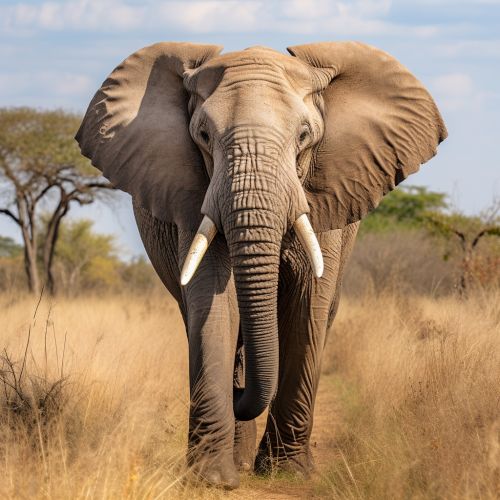African Elephant
Taxonomy and Evolution
The African elephant (Loxodonta) is a genus comprising two living elephant species, the African bush elephant (Loxodonta africana) and the smaller African forest elephant (Loxodonta cyclotis). Both are herbivores and are distinguished by their highly dexterous trunk, long curved tusks, and massive ears, which are used to dissipate heat.


The genus Loxodonta was first described by Frédéric Cuvier in 1825. The name refers to the lozenge-shaped enamel of the molar teeth, which differs significantly from the shape of the Asian elephant's molar enamel. The African elephant is part of the family Elephantidae, the only surviving family of the order Proboscideans.
Physical Characteristics
African elephants are the largest terrestrial animals, with males standing 3.2–4.0 m (10–13 ft) tall at the shoulder and females standing slightly shorter at 2.2–2.6 m (7–9 ft) tall. The body weight of African elephants varies by sex and subspecies; male bush elephants can weigh up to 6,048 kg (13,334 lb), while the smaller forest elephants weigh up to 2,700 kg (6,000 lb).
The skin of the African elephant is 2.5 cm (1 in) thick in most places. The skin is highly sensitive, despite its thickness, and is used in social interactions and for protection against environmental hazards such as thorns. The large ears of African elephants also serve several purposes. The ears' large surface area helps to dissipate heat and keep the elephant cool. They are also used in displays of aggression and dominance.
Habitat and Distribution
African elephants inhabit a diverse range of landscapes, from the open savannah to the dense rainforest. The African bush elephant is typically found in grasslands, marshes, and lake shores, and it ranges over much of the savannah zone south of the Sahara. The African forest elephant, on the other hand, inhabits the dense African rainforests of central and western Africa.
Behaviour and Ecology
African elephants are highly social animals, living in groups called herds. These herds are matriarchal, led by the oldest and often largest female in the group. The matriarch's knowledge of the environment and its resources, such as food and water sources, is crucial for the survival of the herd.
Elephants communicate using a variety of sounds, movements, and touch. They use infrasound, a sub-sonic rumbling, which can be felt by the sensitive skin of an elephant's feet and trunk, which is thought to aid in long-distance communication.
Conservation Status
African elephants are listed as vulnerable by the IUCN, with the African forest elephant being considered critically endangered. The primary threats to African elephants are habitat loss, human-elephant conflict, and poaching for ivory and bushmeat.
